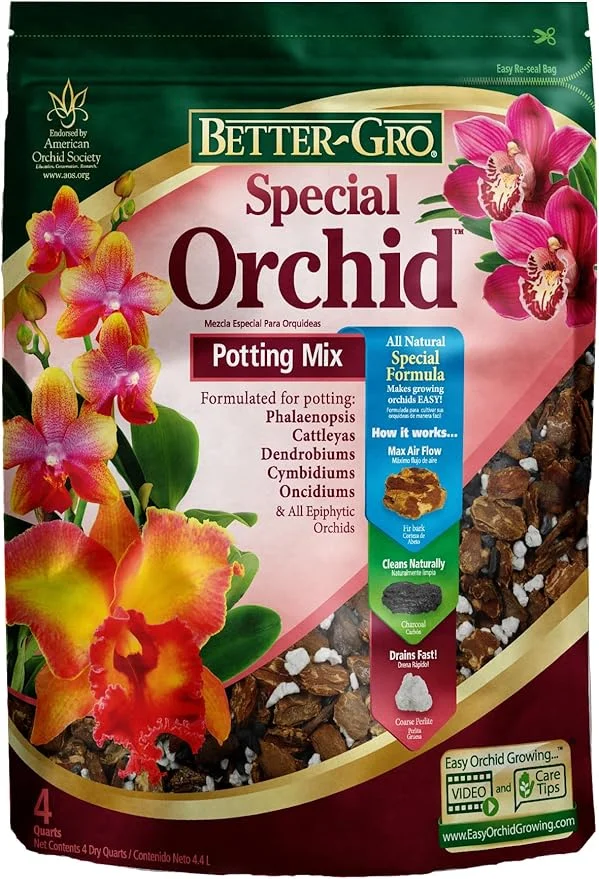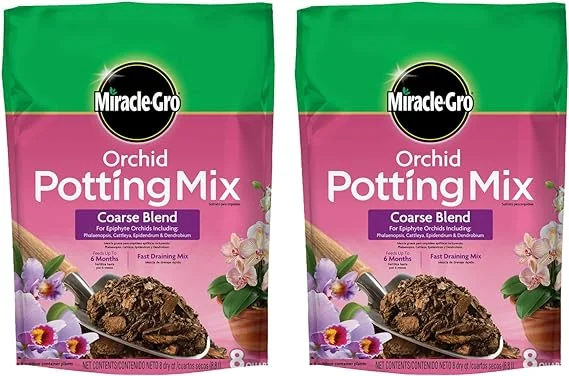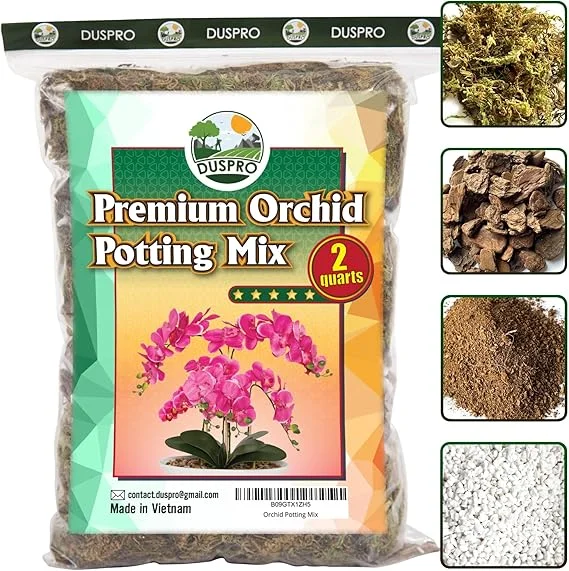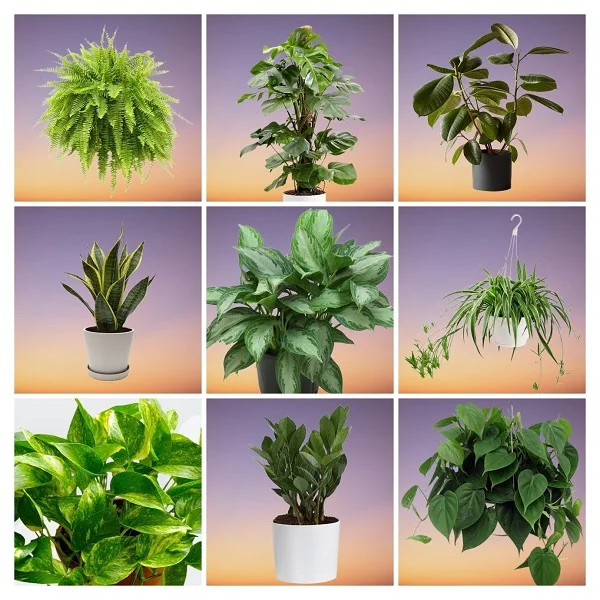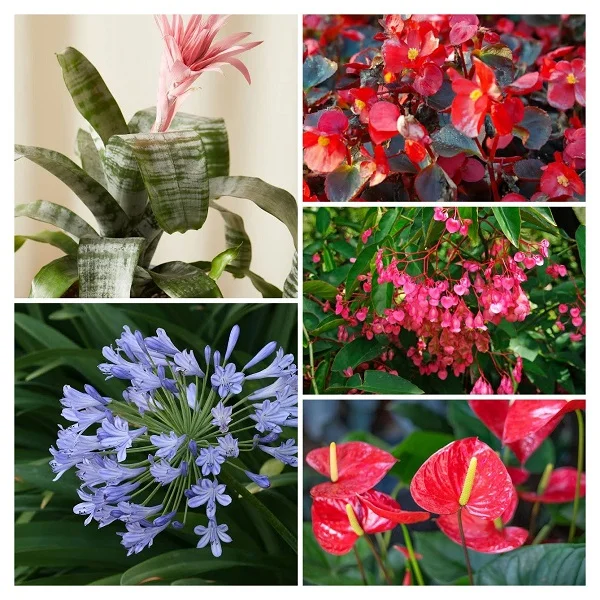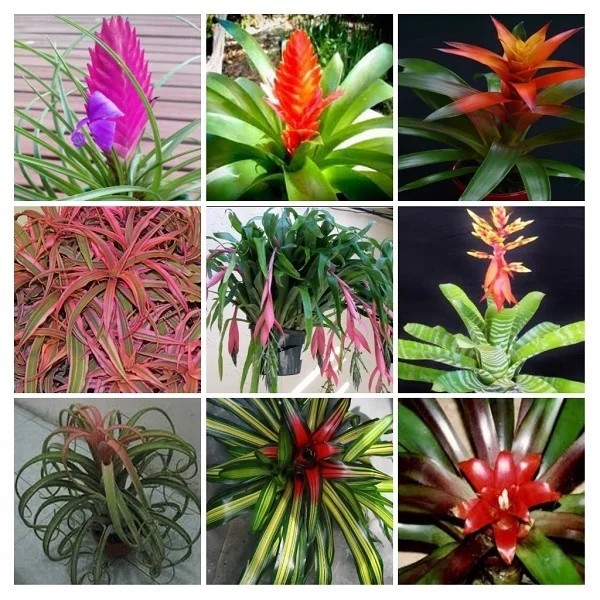Oncidium (Dancing Lady) Orchids Indoor Care, Propagation, Problems and Solutions
Some links in this post may be affiliate links
Dancing Lady (Oncidium) Orchids thrive in bright light with some sunshine, warm and humid conditions and moderately moist, rich, well-drained soil coupled with fortnightly feeding in the growing season.
Oncidium Orchids also called Golden Shower Orchids or Spray Orchids are popular Orchids which are grown for their profusion of brightly colored flowers with a dominant enormous lip.
They produce a profusion of small flowers with a dominant enormous lip which partially blocks the small petals and sepals.
Dancing Lady orchids are magnificent bloomers where a well cared for plant can produce 6-7 branched sprays of flowers which look like a cloud of buttery butterflies which last for weeks. The flowers come in shades of yellow, red, white and pink.
Most of the Oncidiums grown indoors have large pseudobulbs and their long leaves about 2 feet long emerge from the pseudobulbs. The roots are a mass of thin white roots.
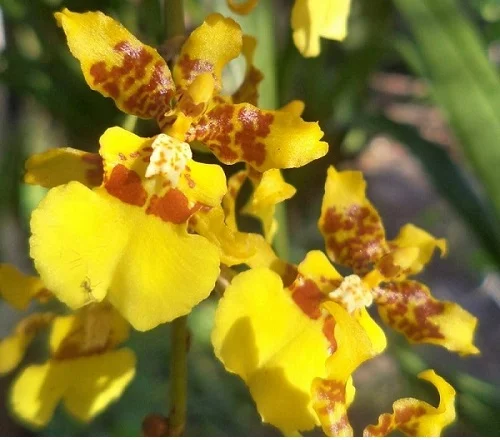
Botanical name: Oncidium
Subfamily: Epidendroideae
Tribe: Cymbidieae
Subtribe: Oncidiinae
Common names: Dancing Lady Orchid, Golden Shower Orchid, Spray Orchid
Origin
Oncidium is a genus of orchids distributed across South America, Central America and West Indies. They usually occur in seasonally dry areas.
The genus name Oncidium is derived from the Greek word onkos meaning "swelling" in reference to the callus at the lower lip. The genus name is abbreviated as Onc. in horticultural journals. Many hybrids and cultivars of Oncidium Orchids have been developed.
Are Oncidium Orchids toxic?
No. Oncidium Orchids are non-toxic to both humans and pets as indicated by ASPCA. They are safe for cats, dogs and other pets in the home.
Where to Buy
Would you like to add Dancing Lady Orchids to your collection? You may obtain them online from Amazon (Link to Amazon) or from Etsy (Link to Etsy).
How to care for Dancing Lady Orchids indoors
To care for Dancing Lady Orchids indoors, provide bright light with 4-6 hours of direct sunshine, average warmth of 15-290C, moderate humidity of 50-55% and moderately moist, fertile, chunky, well-drained soil coupled with fortnightly feeding during the growing season.
Oncidium Orchids care requires regular pruning to keep them neat as well as encourage flowering. Repotting is needed only when they become pot-bound or the soil becomes completely broken down. Keep reading for more on these growing conditions and how to provide them.
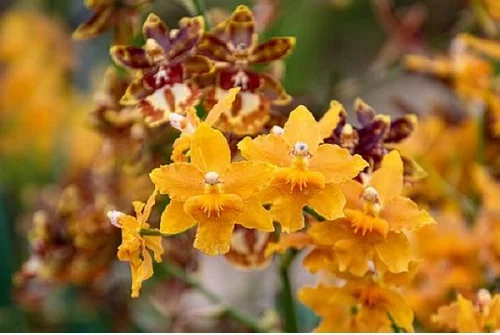
Light Requirements
Do Dancing Lady Orchids like full sun?
Dancing Lady Orchid grows best in bright light with 4-6 hours of morning or late afternoon sunlight. Keep it away from hot midday sunshine to avoid scorching the leaves.
An Oncidium Orchid that is receiving the right amount of light has light-green leaves. Yellowish leaves means that the orchid is receiving too much light, therefore, move it to a more shaded spot.
Dark green leaves indicate that the orchid is not receiving enough light. Therefore, place it in brighter light or use a full spectrum grow light if the natural lighting is inadequate.
Regularly give the pot a quarter-turn to ensure that the orchid receives adequate light on all sides for a balanced growth.
Watering
How often should Oncidium Orchids be watered?
Water your Oncidium Orchid thoroughly in spring and summer while allowin the top half of the soil to dry out between waterings. Keep the soil moderately moist and avoid overwatering to prevent yellowing and rotting.
Cut down on watering in fall and winter as growth is minimal at this time to maintain the soil slightly moist. However, do not allow the soil to dry out completely.
Drooping or wrinkly leaves indicate that you are underwatering the orchid. The leaves of a well watered Oncidium Orchid are firm and smooth.
Use water that is at room temperature to avoid shocking the plant as it can cause reduced growth. In addition, avoid wetting the foliage to minimize fungal diseases.
Dancing Lady Orchids are sensitive to chlorine and other chemicals dissolved in water, therefore, water with chlorine-free water like rain water or filtered water.
Golden Shower Orchids like Brassavola Orchids are more tolerant to dry soil due to their tubular shaped leaves which are designed to reduce water loss through transpiration. As such, take care not to overwater.
Temperature and Humidity
Oncidium Orchids flourish in an average warmth of 15-290C. Warmer days and cooler night temperatures with a difference of 10-150C are ideal for thess orchids. The cool nights are essential to trigger flowering.
Keep the orchids away from drafts to avoid sudden changes in temperature which can cause reduced growth. Make sure that there is good air circulation to minimize fungal diseases.
Dancing Lady Orchids like a moderate humidity of 50-55%. Dry air can result in brown leaf tips. Therefore, set the pot on a wet pebble tray or use a humidifier to increase humidity. Do not mist the leaves as it can lead to fungal disease infestations.
Fertilizer
What is the best fertilizer for Oncidium Orchid?
Feed Oncidium Orchid with an orchid's fertilizer in spring and summer as per the manufacturer's instructions. Do not feed in fall and winter as growth is reduced at this time.
Do not feed an orchid that is in flower as it can shorten the flowering period. Avoid overfeeding the orchid as it may result in loss of the roots and death of the orchid. Overfeeding can also lead to vegetative growth at the expense of flower production.
Potting Mix
What is the best medium for Dancing Lady Orchids?
Pot your Dancing Lady Orchid in a rich, loose, chunky, well-drained orchid soil to avoid waterlogging which can result in rotting and death of the plant.
Repotting
Oncidium Orchid blooms best when pot-bound. Repot only when growth begins to suffer; when the orchid has outgrown its pot and the new growth reaches out over the edge of the pot or when the soil has broken down completely.
Basically repotting Dancing Lady Orchid every 2-3 years should be adequate. Repot it only when new growth begins, shortly after blooming is over. Do not repot an orchid that is in flower as it may shorten the flowering season.
The best pot should be only 1 size larger than the current one and with proper drainage holes or slits as the roots need good air circulation. Take a look at these orchid pots with a free slotted orchid pot liner on Amazon.
When repotting, shake off excess soil and trim off any dried and shrivelled pseudobulbs. The large orchid (one with about 6 or more pseudobulbs) should be divided, (retain 3 shoots on each section) to propagate new plants.
Pruning & Grooming
How do you prune a Dancing Lady Orchid?
Pruning Dancing Lady Orchid involves removal of dead and diseased leaves by cutting them at the base with sharp scissors or a knife.
When flowering is over, cut the flower stalk 1 inch above the 3rd node from the bottom to encourage more flowers.
Occasionally clean the leaves by damp-wiping with a soft cloth to get rid of dust as well as discourage pest and disease infestation.
Oncidium Orchid Propagation
Oncidium Orchids (Dancing Lady Orchids) propagation is done from rhizomes or from keikis (baby orchids) at the beginning of the growing season when in active growth.
Propagating Dancing Lady Orchid by rhizome division
- Gently split the rhizome into sections while ensuring there are at least 3 shoots on each section.
- Seperate the roots attached to each division from the mother root-ball.
- Select a pot about 1-2 inches larger than the pseudobulb. Confirm that the pot has enough drainage holes and slits to prevent rotting.
- Remove the old potting soil attached to the roots and place each section in the center of the pot.
- Bury the roots of the section in orchid's soil while ensuring that the bottom of the pseudobulb is level with the top of the soil.
- Stake each newly repotted plant to prevent it from toppling over.
- Place the set up in a warm, well-lit place away from direct sunlight until the sections have established their own roots.
- Water the new orchids lightly to enhance root development. Allow enough time for substancial growth after which you can begin routine care.
Propagating Dancing Lady Orchid from keikis
Oncidium Orchids naturally produce "baby" orchids called "keiki" which normally appear on an old or new flower spike. Keikis are identical copies of the parent plant.
Keiki growth can be triggered by prolonged exposure to high temperature during the final phase of spike growth.
- Detach the keiki from the mother when about one year old when it has developed 2-3 leaves and 1-3 inches long roots.
- Pot the keiki in fresh potting medium and direct the roots of the keiki downwards.
- Provide support to prevent the keiki from toppling over.
- Position the set up in a well-lit, brightly-lit place and mist the keiki regularly to maintain a humid enviroment.
- Allow the new orchid to be well established before transplanting it after which you can begin routine care.

Oncidium Orchids Problems & Solutions
Oncidium Orchids (Dancing Lady Orchids) problems include brown leaves, yellow leaves, lack of blooms, brown leaf tips, drooping leaves, pests and diseases among others. Keep reading for more details on these problems and how to solve them.
Brown leaves
Why are the leaves on my Dancing Lady Orchid turning brown?
The leaves on your Dancing Lady Orchid are turning brown due to soggy soil, inconsistent watering, drafts, hot sunshine, and aging.
How to fix it
Soggy soil: Use a pot that has adequate drainage and soil that is well-draining.
Inconsistent watering: Water when the top half of soil feel dry to the touch. Do not water on a schedule.
Drafts: Keep the orchid away from both hot and cold drafts.
Hot sunshine: Place the orchid in a shadier spot or instal a sheer curtain to shield it from direct sunshine.
Aging: This is a natural process; as the orchid matures the lower leaves begin to die, turn yellow, then brown and eventually drop off.
Yellow leaves
Why are my Dancing Lady Orchid leaves turning yellow?
Your Dancing Lady Orchid leaves are turning yellow due to inconsistent watering, soggy soil, too little light, nutrients deficiency, and aging.
How to fix it
Inconsistent watering: Water when the top half of soil feel dry to the touch. Do not water on a schedule.
Soggy soil: Use a pot that has adequate drainage and soil that is well-draining.
Too little light: Move the orchid to a brighter spot or use a grow light if the natural light is not adequate.
Nutrients deficiency: Feed with an orchid's fertilizer in spring and summer as directed by the manufacturer.
Aging: This is a natural process; as the orchid matures the lower leaves turn yellow, then brown and eventually fall off.
Lack of blooms
Why is my Dancing Lady Orchid not flowering?
Your Dancing Lady Orchid is not flowering due to too little light, overfeeding, dry air, drafts, and inconsistent watering.
How to fix it
Too little light: Place the orchid in a brighter spot or instal grow lights if the natural light is not adequate.
Overfeeding: Too much fertilizer can result in vegetative growth at the expense of flowers production. Feed in spring and summer only and take care not to overfeed.
Dry air: To raise humidity use a wet pebble tray or a cool mist humidifier.
Drafts: Keep the orchid away from drafts coming from AC units, hot air vents, windy doors, drafty windows among others.
Inconsistent watering: Do not water on a schedule. Water when the top half of soil feel dry and never allow the soil to dry out completely.
Brown leaf tips
Brown leaf tips on Dancing Lady Orchid are due to hard water, underwatering, low humidity and temperature stress.
How to fix it
Hard water: Use chlorine-free water like rain water or filtered water to water the orchid.
Underwatering: Water when the top half of soil feel dry but never allow the soil to dry out completely.
Temperature stress: Keep the orchid away from drafts emanating from AC units, hot air vents, windy doors, drafty windows among others.
Drooping leaves
Drooping leaves on Dancing Lady Orchid are caused by underwatering, hot sunshine, extreme temperatures, and pests infestations.
How to fix it
Underwatering: Water when the top half of the soil dry, however, do not let the soilball dry out completely.
Hot sunshine: Keep the orchid away from midday sunshine or use a light curtain to filter the sunlight.
Extreme temperatures: Avoid drafts originating from stoves, hot surfaces, AC units, windy doors and windows, hot air vents and others.
Pests infestations: Regularly inspect the orchid for pests and take timely control measures.
Pests
Common pests of Dancing Lady Orchid are mealybugs, scale insects, slugs and snails infestation.
How to fix it
- Isolate the affected orchid to prevent spread to other plants.
- Treat the orchid with neem oil or insecticidal soap. Take care to follow the manufacturer's instructions.
- Regularly damp-wipe the leaves with a soft cloth to discourage the pests.
- Keep the orchid well pruned to minimize the hiding and breeding places for these pests.
Diseases
Dancing Lady Orchid is prone to the following two diseases:
1. Powdery mildew which is prevalent in damp conditions coupled with poor air circulation. It presents a whitish-gray mold on the leaves.
How to fix it
- Remove the affected leaves and discard to reduce spread to other parts of the plant.
- Improve ventilation to ensure that there is good air circulation for the orchid.
- Do not mist the orchid and avoid wetting the foliage during watering.
2. Leaf spot disease which presents as brown soft spots on leaves. In a serious attack the spots can enlarge and merge, killing the whole leaf.
How to fix it
- Remove the affected leaves immediately to prevent further spread.
- Maintain a good air flow to minimize the disease occurence.
- Avoid wetting the foliage during watering. You water from the bottom.
You liked it? Share on social media.
Related Content
Amazon Associates Disclosure
Homeplantsguide.com is a participant in the Amazon Services LLC Associates Program, an affiliate advertising program designed to provide a means for sites to earn advertising fees by advertising and linking to amazon.com.
